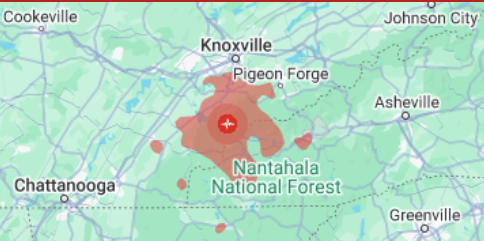Many people across East Tennessee felt an earthquake Saturday morning.
According to the United States Geological Survey, the 4.1 magnitude earthquake ranks among the strongest felt in our area and the strongest since a 4.4 magnitude earthquake in Decatur in 2018. There could be an aftershock possible this week.
However, the strongest earthquake here belongs to one which had its epicenter in Maryville back in 1973. It was reported to be a 4.7 magnitude earthquake.
A brief gas leak and many roads, dams, bridges and attractions are inspected following a 4.1 magnitude earthquake.
Just after 9:00 a.m. on Saturday the United States Geological Survey reported the earthquake which was felt across East Tennessee.
The preliminary report from USGS says the earthquake was felt as far as Atlanta, Ga. The agency also forecasted a 23% chance for an aftershock, which could happen in the coming week.
The epicenter is reported to be out of Blount County. As far as damage, the Tennessee Department of Transportation’s Mark Nagi says they had no reports of damaged roads but would be inspecting bridges throughout the next few weeks as a precaution.
Rural Metro Fire’s Jeff Bagwell said there was a brief gas leak in West Knox County but that was the only call they responded to because of the earthquake.
The Blount County Emergency Management Agency Director says there were no reports of injuries or damage across the county but they did receive lots of phone calls.
WVLT spoke with a Tennessee Valley Authority representative who said the only dam that saw enough movement to require inspection was Fontana Dam, which saw no issues.
Multiple attractions in Sevier County. Dollywood, Wilderness in the Smokies and The Island in Pigeon Forge each reported no damage to any of their rides or attractions.
The Tennessee Emergency Management Agency is working with local, regional and state partners to determine impacts and any needs following the earthquake.
The Great Smoky Mountains National Park said a portion of Foothills Parkway West was shut down from the earthquake, but it reopened Sunday morning after an inspection by the Federal Highway Administration found there was no damage.
The University of Tennessee says its Facilities Services team has inspected buildings across campus to ensure there was no visible damage or structural concern after Saturday morning’s 4.1 magnitude earthquake.
University officials say residence halls and Lindsey Nelson Stadium were assessed first, and at Food City Center a visual inspection of the facility was completed and found no structural damage ahead of this weekend’s commencement ceremonies.
Officials are asking students and faculty to report any visible signs of damage, such as cracks, when they return to campus today (Monday). Issues can be reported through the Safe at UT app, by email or by calling 865-946-7777.
The University says they will continue to monitor buildings and infrastructure for any signs of damage.
Tuckaleechee Caverns’ seismograph in Townsend is considered to be the most sensitive seismic station on Earth.
Officials says Saturday’s 4.1 magnitude earthquake was the biggest quake they’ve felt in the area.
They say it was pretty deep, about 25 kilometers underground, and we have ancient fault lines here.
Officials say this machine is the most sensitive seismic station on Earth and was placed here to monitor nuclear missile testing.
While the earthquake was brief, an aftershock is possible but not guaranteed.
















